The first part of this series on historical American Optical lenses and the Optical Heritage Museum provided an overview of the lenses and information from the 1920s. Part Two covered the American Optical (AO) groundbreaking progressive lens designs released from 1978 to 1990.
Part Three of this series provides an overview on each of the American Optical progressive lenses from 1990 to present day along with my personal insights, lens design background and materials.
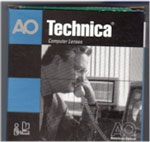
Truvision Technica Computer Lens, 1990
Technica was a first of its kind progressive with a unique design that was ideal for use when viewing computer screens. It was a fully functional progressive lens with a small but useable distance portion with an intermediate that was "the width of the lens" and a decent reading portion.

The Technica computer lens design was designed with the distance and near portion verification points centered 18mm above and below the 180 line as shown below. This meant that the lens could be fabricated and verified with a distance and near Rx as written, with no special treatment by the lab or ECP's. This was not always understood when trying to promote the lens, but this feature made this product a truly innovative lens. Notice the blocking point is not directly below the fitting cross (inverted T). This topic came up during my first ISO Meeting in Munich in 1991, when we were working on a progressive lens marking standard—ISO 10322-2. Innovative designs like Technica requiring the blocking point to be offset as shown, were being overlooked. The norm was to always center this point between the traditional 34mm hidden markings, but this was corrected when the experts were apprised of this new feature.

AO Pro 15, 1992
Turning our attention back to general-purpose progressive lenses, the next product was the highly successful AO Pro series of lenses. During the OMNI period, which preceded it, Dr. Winthrop often commented that because OMNI was the ultimate in smooth designs, he did not see that it could be improved upon. This was far from the case, however as subsequent designs pushed the envelope to new and notable designs.
The AO Pro lens design backed off on the amount of allowable power errors in the distance portion area, from that of the OMNI design. The AO Pro distance portion was made more spherical than the OMNI, and seemed to strike a very good balance that was well received by all users of this lens.
During this lens design introduction I took over responsibility for providing all processing support. My function included generating surfacing charts, instructions to Rx vendors for surface description files and issuance of product specifications. This work continued for the next 12 years and I helped support the remaining products discussed in this article. Needless to say this was a valuable learning curve and one that gives me a special appreciation of what was needed to produce these AO progressive lens products.
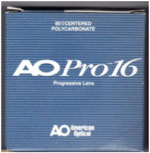
AO Pro 16, 1994
The AO Pro 16 was a design extension of the AO Pro 15 with the following exceptions:
- The semi-finished blank was produced as an 80mm centered product in Polycarbonate (hence the 16). All AO Pals since the Truvision design had been provided in decentered blank form, where the blocking point was not at the center of the blank. This permitted the lens to effectively allow larger eye sizes but decentered designs confused some when processing the lens. The 80mm centered feature was an attempt to make it easy to use for those processing the lens.
- The DP curve choice was made slightly flatter and as such an additional aspheric term was added to the design to address this. Dr. Winthrop asked me to work with him to derive this function, at that time a major part of my work was the designer of AO's aspheric single vision lenses such as ASPHERLITE and AO 55 semi-finished and Finished Single Vision products.

AO Force 55, 1996
The AO Force 55 was a tweak of the AO Pro, where it was only offered in a mid-index plastic material. This was why it was called '55' indicating 1.55 nominal index for the material. AO was predicting at that time that standard index plastic would be replaced by mid index materials, which did not turn out to be the case.
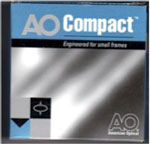
AO Compact, 1998
A truly groundbreaking achievement came with the introduction of the AO Compact lens in 1998. This lens was the first to be specifically designed for smaller frames and became one of the most successful selling progressive lenses of all time for AO. It began when Claude Labeeuw (AO Switzerland, now Zeiss VP Marketing) asked Dr. John Winthrop if he could design a lens for small frames. Boy did John come thru with an answer to that question!
I recall traveling to London during the development of phase of this lens and hand carrying pre-production samples for approval by Management. At that time, little did we know what a terrific innovation this was, although we suspected it would be a worthwhile addition to AO's portfolio. Click here to download Dr. Winthrop's white paper on the AO Compact. Note: This is a 2MB PDF and may take a moment to download.
The Compact is still being sold by Zeiss today and was the winner of the OLA Award of Excellence for lens design back when first introduced.
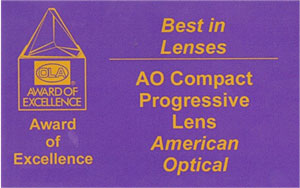

AO b' Active, 2000
The AO b' Active was an attempt to fill in a niche market that might have potential—active people. Sports oriented people who did not need a large reading area. This design had a small but functional reading area, putting its emphasis on clarity of vision for intermediate and far. While successful and a sound design, it was not the success of AO Compact. I recall during the pre-launch phase that Darryl Meister visited Southbridge and interfaced with the AO R&D team. It was a memorable time, and an interesting mix of AO and SOLA philosophies with regard to technical marketing, which prior to that had been largely isolated from one another.
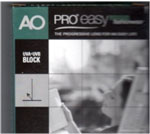
AO Pro Easy, 2002
I was personally most involved with the AO Pro Easy product. I was assigned by Karen Roberts (SOLA/AO/now Zeiss) the task to work with Dr. Winthrop and help on the design and product development. I did this for several material releases for this product. Dr. Winthrop worked with me to give guidance on the design he was seeking and I derived the actual design parameters. This was a steep learning curve for me, but was a fun and challenging experience. This new design permitted some additional power error to be allowed into the distance area from the AO Pro design, but not to the degree of the OMNI. This lens was well received and still is sold today. I am proud to have had a part in this product line.
Subsequent to the AO Pro Easy, Dr. Winthrop's final contribution was the Compact Ultra, which was released after Zeiss merged with AO/SOLA in 2006 to become Carl Zeiss Vision. It provided an even shorter corridor Compact design for smaller frames.
Today, Zeiss continues to provide new Progressive lens designs and processing technology. With the introduction of Free-form technology first introduced to the market by Zeiss, new designs are continuing to provide improved and refined optical performance features from what has been described here. The AO Progressive lens lineage of products, however, laid an important foundation for progressive lens design which is still of influence to the market today.
CLICK HERE to access a PDF chart with all the lenses described above along with lens specifications for each lens.












